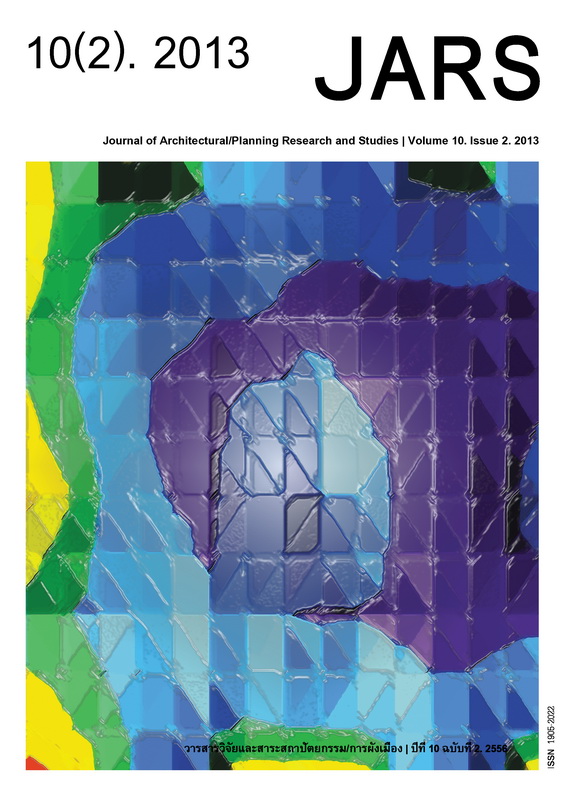Research Collaboration with the Architectural Design Process: Co-Development of Problems and Solutions
Main Article Content
Abstract
This research aims to investigate what a possible framework design research can be integrated withthe architectural-design process. The process of design embodies dialectics between generation of form andresearch. How strategic design research is cooperative into design processes to achieve the design solutionhas been barely examined in a broad range of the architectural-design practices. The study thus explores acomparative analysis of the design processes in different design practice between third-year architecture students,fifth-year architecture students, and architects, to examine various forms of design research taking place infinding and solving problems.
Findings reveal that design research lies in investigative modes and processing of external knowledgerelevant to problems, thereby enabling for a decisive solution. Research cooperates with the design process aslearning tensions between problems and solutions. However, the problem-solution pairing and research takingplace do not promise the successful solution. The acceptable design unfolds continuous improvement betweena series of problems-solutions through which research induces the co-development of problems-solutionsframework from an abstract idea to concrete levels of design development in three situations: “understandingcriteria and formulating goals,” “exploring possibility,” and “examining reality.” Moreover, practitioners mostly drawupon more design visions to direct problem-framing, research, and working methods to meet design goals thannovice students operate research into the process of design.
To effectively implement research into the design process, a designer could consider design activity asa critical learning process as the co-development of problems-solutions framework to operate design strategiesand thinking. This mode of design thinking will allow design research roles to collaborate with problem-framingand design methods into the design process.
Downloads
Article Details

This work is licensed under a Creative Commons Attribution-NonCommercial-NoDerivatives 4.0 International License.
All material is licensed under the terms of the Creative Commons Attribution 4.0 International (CC-BY-NC-ND 4.0) License, unless otherwise stated. As such, authors are free to share, copy, and redistribute the material in any medium or format. The authors must give appropriate credit, provide a link to the license, and indicate if changes were made. The authors may do so in any reasonable manner, but not in any way that suggests the licensor endorses you or your use. The authors may not use the material for commercial purposes. If the authors remix, transform, or build upon the material, they may not distribute the modified material, unless permission is obtained from JARS. Final, accepted versions of the paper may be posted on third party repositories, provided appropriate acknowledgement to the original source is clearly noted.
References
Antoniades, A. (1992). Poetics of architecture: Theory of design. US: John Wiley & Sons.
Augustin, S., & Coleman, C. (2012). The designer’s guide to doing research: Applying knowledge to inform design. US: John Wiley & Sons.
Bamford, G. (2002). From analysis/synthesis to conjecture/analysis: A review of Karl Popper’s Influence on design methodology in architecture. Design Studies, 23, 245-261.
Cross, N. (2007). Designerly ways of knowing. Germany: Birkhauser Verlag AG.
Cross, N. (2011). Design thinking: Understanding how designers think and work. UK: BERG.
Darke, J. (1979). The primary generator and the design process. Design Studies, 1(1), 30-44.
Dorst, K., & Cross, N. (2001). Creativity in the design process: Co-evolution of problem-solution. Design Studies, 22(5), 425-37.
Downing, F. (1989). Image banks: The purposes, function, and meaning of environmental imagery for architectural designers, dissertation. Ann Arbor: UMI.
Ganshirt, C. (2007). Tools for ideas: An introduction to architectural design. Germany: Birkhauser Verlag AG.
Groat, L., & Wang, D. (2002). Architectural research methods. US: John Wiley & Sons.
Hengrasmee, S., & Chansomrak, S. (2011). ปฏิบัติการออกแบบสถาปัตยกรรมที่เป็นมิตรกับสิ่งแวดล้อม: กรณีศึกษาจากรายวิชาสตูดิโอพิเศษ [Environmentally friendly architectural design studio: A studio based case study]. Journal of Architectural/Planning Research and Studies, 8(1), 97-108.
Horayangkura, V. (2002). Can design be considered as research? Journal of research methodology, 15(2), 167-183. Horayangkura, V. (2004). Integration through innovation. Journal of architectural research and studies, 2, 87-100.
Jan Stappers, P. (2007). Doing design as part of doing research. In R. Michel (Ed.), Design research now (pp. 81-91). Germany, Birkhauser Verlag AG.
Lawson, B. (2004). What designers know. China: Architectural Press.
Lawson, B. (2006). How designers think: The design process demystified (4th ed.). Hungary: Architectural Press.
Lincoln, Y., & Guba, E. (1985). Naturalistic inquiry. Thousand Osks: Sage.
Maher, M., Poon, J., & Boulanger, S. (1996). Formulizing design exploration as co-evolution: a combined gene approach. In J. Gero & F. Sudweeks (Eds.), Advances in formal design methods for CAD. London: Chapmen and Hall.
Pena, W., & Parshall, S. (2001). Problem-seeking: An architectural programming primer (4th ed.). New York: John Wiley & Sons.
Rowe, P. (1991). Design thinking (3rd ed.). Cambridge: The MIT Press.
Schneider, B. (2007). Design as practice: Science and research. In R. Michel (Ed.), Design research now (pp. 81-91). Germany, Birkhauser Verlag AG.
Zeisel, J. (2006). Inquiry by design: environmental/behavior/neuroscience in architecture, interior, landscape, and planning. US: W.W. Norton & Company.


